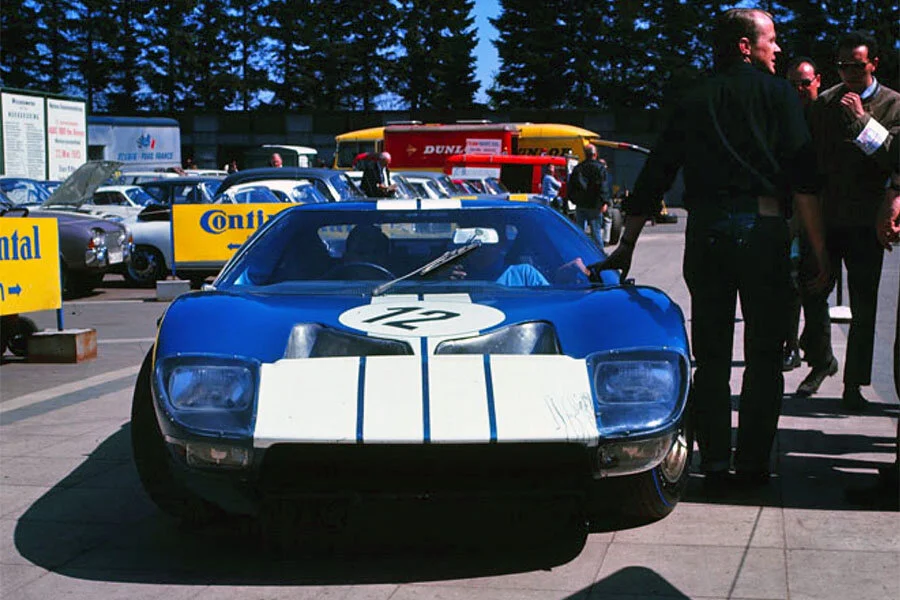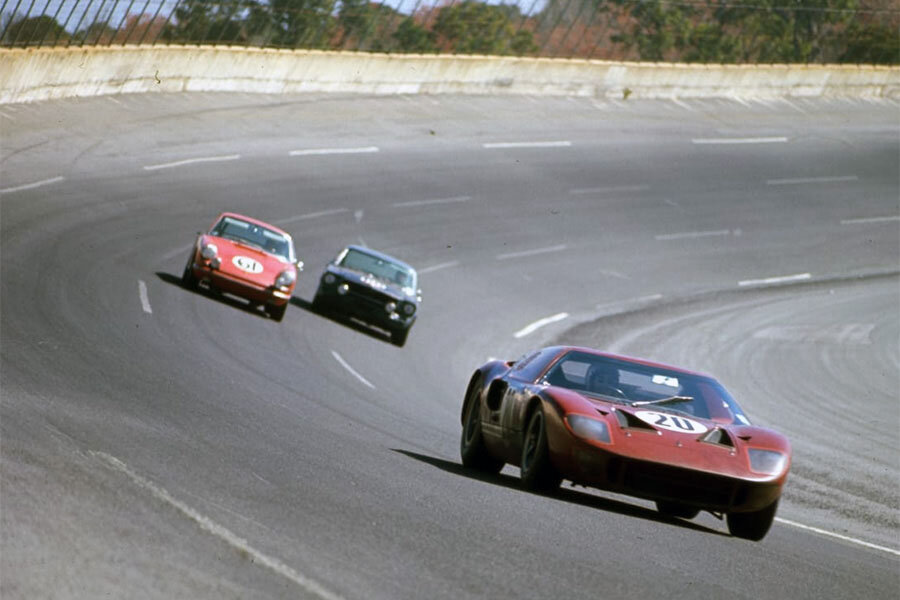VIN: the works / Shelby / William Wonder Ford GT40 Prototype Mk1 chassis GT/103
/HISTORY OF CHASSIS GT/103
GT/103 was the third GT40 Prototype completed. It was one of five examples used for the model’s debut campaign in 1964.
GT/103 first raced at the Le Mans 24 Hours. Driven by Richie Ginther and Masten Gregory, it qualified fastest of the GT40s in second position.
Having initially dropped to fourth on lap two, Ginther then hurtled by the trio of Ferraris ahead of him to lead for the next 25 laps. When Ginther came in to refuel, the Ferraris took over at the head of the field.
GT/103 subsequently retired at around 9pm owing to gearbox failure. None of the other Fords finished either as Ferrari swept the top three positions.
GT/103’s next appearance was at the Reims 12 Hour World Sportscar Championship race two weeks later. Ginther and Gregory were once again behind the wheel and started from second position as the lead Ford.
The race began at midnight. By lap ten, Ginther was in the lead.
However, he was at the head of the field for little over an hour before coming to a stop with a broken crown wheel and piston.
Towards the end of 1964, GT 103 and GT 104 were dispatched to Shelby American who were brought on board as a development partner.
Now equipped with 4.7-litre engines, the two cars were sent to Nassau for the end-of-season Bahamas Speed Week.
Phil Hill drove GT 103 to third overall and first in class in the Tourist Trophy Preliminary, but then posted a DNF in the main event after he suffered a suspension failure.
For 1965, GT/103 remained with Shelby. It was enhanced to the latest specification with improvements to the aerodynamics, cooling and engine. During the course of the season, the original Colotti ‘box was exchanged for a more reliable ZF unit.
Now painted blue with white stripes, GT 103 qualified third for its maiden race of the year: the Daytona 2000km. After retirements for a couple of faster cars, Ken Miles and Lloyd Ruby took the GT40’s first major victory.
At the Sebring 12 Hours, Miles was joined by Bruce McLaren. GT/103 again qualified third. This time it finished second behind the winning Chaparral of Jim Hall / Hap Sharp.
McLaren then posted seventh fastest time at the annual Le Mans Test before he joined up with Miles for the Monza 1000km. GT/103 started fifth and finished third as Ferrari P cars took first and second places.
GT/103’s final race as a works machine was at the Nurburgring 1000km. For this event, it was fitted with an experimental 5.3-litre motor.
Hill and McLaren qualified fourth.
GT/103 ran in second position for much of the first hour until Hill retired out on the circuit with transmission failure.
GT/103 was subsequently fitted with a standard 4.7-litre engine and rebuilt to Mk1 production specification. In this configuration, it was sold to American Airlines engineer, William Wonder, of New York.
Wonder started racing in the early 1950s. He began with an MG TD in 1953 and moved on to an Austin-Healey 100 for 1954. This was followed by a Frazer Nash Mille Miglia (1955 and 1956), a Maserati 200 SI (1957), an AC Ace (1958 and 1959) a Porsche 550 (1960 and 1961) and a Porsche 718 RS (1962).
The now dark red GT40 replaced a Genie Mk8 that Wonder had used for the 1964 and 1965 seasons.
William Wonder ran GT /03 ten times between 1966 and 1970 including five back-to-back appearances at the Daytona 24 Hours. His best results in Florida were a brace of eighth place finishes in 1967 and 1970.
From 1969, Wonder raced the GT40 alongside a McLaren Elva Mk3. He then moved up to a McLaren M8C for the 1971 and 1972 seasons, but kept hold of the GT40.
William Wonder retained GT/103 until August 2005, when it was sold via RM Auctions in Monterey to the Larry Miller Collection in Utah.
Notable History
Ford Motor Company (Ford Advanced Vehicles)
White & Black livery with Blue stripes
22/06/1964 WSC Le Mans 24 Hours (R. Ginther / M. Gregory) DNF (#11)
05/07/1964 WSC Reims 12 Hours (R. Ginther / M. Gregory) DNF (#5)
Shelby American Inc., California
29/11/1964 BSW Nassau TT Preliminary (P. Hill) 3rd oa, 1st GTP 5.0 class (#91)
29/11/1964 BSW Nassau TT (P. Hill) DNF (#91)
Rebuilt to 1965 spec. and re-painted Blue with White stripes
28/02/1965 WSC Daytona 2000km (K. Miles / L. Ruby) 1st oa, 1st P class (#73)
27/03/1965 WSC Sebring 12 Hours (K. Miles / B. McLaren) 2nd oa, 1st P4.0+ class (#11)
11/04/1965 IND Le Mans Test (B. McLaren) 7th oa, 5th P5.0 class (#11)
25/04/1965 WSC Monza 1000km (K. Miles / B. McLaren) 3rd oa, 3rd P2.0+ class (#69)
23/05/1965 WSC Nurburgring 1000km (P. Hill / B. McLaren) DNF (#12)
Rebuilt to Mk1 specification and repainted Dark Red
Sold to William Wonder (William Wonder Inc.), New York
06/02/1966 WSC Daytona 24 Hours (W. Wonder / H. Wetanson) DNF (#88)
26/03/1966 WSC Sebring 12 Hours (W. Wonder / B. Brown) DNF (#22)
22/05/1966 USR Bridgehampton (W. Wonder) 15th oa, 7th 2.0+ class (#11)
04/06/1966 CSC Player's 200 Mosport (W. Wonder) 12th oa, 3rd Gr.4 class (#111)
05/02/1967 WSC Daytona 24 Hours (W. Wonder / R. Caldwell) 8th oa, 2nd S2.0+ class (#20)
01/04/1967 WSC Sebring 12 Hours (W. Wonder / R. Caldwell) DNF (#14)
04/02/1968 WSC Daytona 24 Hours (W. Wonder / R. Cuomo) DNF (#37)
14/07/1968 WSC Watkins Glen 6 Hours (W. Wonder / R. Cuomo / R. Caldwell) DNF (#7)
02/02/1969 WSC Daytona 24 Hours (W. Wonder / R. Cuomo) DNS (#7)
01/02/1970 WSC Daytona 24 Hours (W. Wonder / R. Cuomo) 8th oa, 5th S class (#18)
08/2005 sold to the Larry Miller Collection, Utah
Text copyright: Supercar Nostalgia
Photo copyright: Ford - https://www.ford.com
































